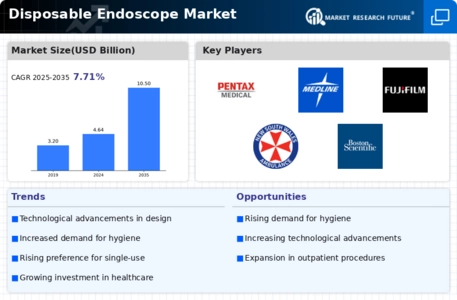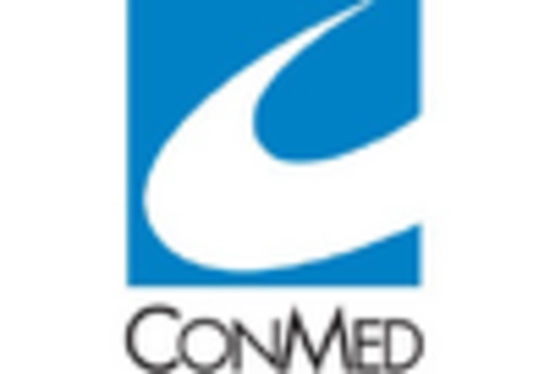Rigid Endoscope
Flexible Endoscope
Video Endoscope
Gastroenterology
Urology
Pulmonology
ENT
Cardiology
Hospitals
Ambulatory Surgical Centers
Specialty Clinics
Direct Sales
Distributors
Online Sales
North America
Europe
South America
Asia Pacific
Middle East and Africa
North America Outlook (USD Billion, 2019-2035)
North America Disposable Endoscope Market by Product Type
Rigid Endoscope
Flexible Endoscope
Video Endoscope
North America Disposable Endoscope Market by Application Type
Gastroenterology
Urology
Pulmonology
ENT
Cardiology
North America Disposable Endoscope Market by End User Type
Hospitals
Ambulatory Surgical Centers
Specialty Clinics
North America Disposable Endoscope Market by Distribution Channel Type
Direct Sales
Distributors
Online Sales
North America Disposable Endoscope Market by Regional Type
US
Canada
US Outlook (USD Billion, 2019-2035)
US Disposable Endoscope Market by Product Type
Rigid Endoscope
Flexible Endoscope
Video Endoscope
US Disposable Endoscope Market by Application Type
Gastroenterology
Urology
Pulmonology
ENT
Cardiology
US Disposable Endoscope Market by End User Type
Hospitals
Ambulatory Surgical Centers
Specialty Clinics
US Disposable Endoscope Market by Distribution Channel Type
Direct Sales
Distributors
Online Sales
CANADA Outlook (USD Billion, 2019-2035)
CANADA Disposable Endoscope Market by Product Type
Rigid Endoscope
Flexible Endoscope
Video Endoscope
CANADA Disposable Endoscope Market by Application Type
Gastroenterology
Urology
Pulmonology
ENT
Cardiology
CANADA Disposable Endoscope Market by End User Type
Hospitals
Ambulatory Surgical Centers
Specialty Clinics
CANADA Disposable Endoscope Market by Distribution Channel Type
Direct Sales
Distributors
Online Sales
Europe Outlook (USD Billion, 2019-2035)
Europe Disposable Endoscope Market by Product Type
Rigid Endoscope
Flexible Endoscope
Video Endoscope
Europe Disposable Endoscope Market by Application Type
Gastroenterology
Urology
Pulmonology
ENT
Cardiology
Europe Disposable Endoscope Market by End User Type
Hospitals
Ambulatory Surgical Centers
Specialty Clinics
Europe Disposable Endoscope Market by Distribution Channel Type
Direct Sales
Distributors
Online Sales
Europe Disposable Endoscope Market by Regional Type
Germany
UK
France
Russia
Italy
Spain
Rest of Europe
GERMANY Outlook (USD Billion, 2019-2035)
GERMANY Disposable Endoscope Market by Product Type
Rigid Endoscope
Flexible Endoscope
Video Endoscope
GERMANY Disposable Endoscope Market by Application Type
Gastroenterology
Urology
Pulmonology
ENT
Cardiology
GERMANY Disposable Endoscope Market by End User Type
Hospitals
Ambulatory Surgical Centers
Specialty Clinics
GERMANY Disposable Endoscope Market by Distribution Channel Type
Direct Sales
Distributors
Online Sales
UK Outlook (USD Billion, 2019-2035)
UK Disposable Endoscope Market by Product Type
Rigid Endoscope
Flexible Endoscope
Video Endoscope
UK Disposable Endoscope Market by Application Type
Gastroenterology
Urology
Pulmonology
ENT
Cardiology
UK Disposable Endoscope Market by End User Type
Hospitals
Ambulatory Surgical Centers
Specialty Clinics
UK Disposable Endoscope Market by Distribution Channel Type
Direct Sales
Distributors
Online Sales
FRANCE Outlook (USD Billion, 2019-2035)
FRANCE Disposable Endoscope Market by Product Type
Rigid Endoscope
Flexible Endoscope
Video Endoscope
FRANCE Disposable Endoscope Market by Application Type
Gastroenterology
Urology
Pulmonology
ENT
Cardiology
FRANCE Disposable Endoscope Market by End User Type
Hospitals
Ambulatory Surgical Centers
Specialty Clinics
FRANCE Disposable Endoscope Market by Distribution Channel Type
Direct Sales
Distributors
Online Sales
RUSSIA Outlook (USD Billion, 2019-2035)
RUSSIA Disposable Endoscope Market by Product Type
Rigid Endoscope
Flexible Endoscope
Video Endoscope
RUSSIA Disposable Endoscope Market by Application Type
Gastroenterology
Urology
Pulmonology
ENT
Cardiology
RUSSIA Disposable Endoscope Market by End User Type
Hospitals
Ambulatory Surgical Centers
Specialty Clinics
RUSSIA Disposable Endoscope Market by Distribution Channel Type
Direct Sales
Distributors
Online Sales
ITALY Outlook (USD Billion, 2019-2035)
ITALY Disposable Endoscope Market by Product Type
Rigid Endoscope
Flexible Endoscope
Video Endoscope
ITALY Disposable Endoscope Market by Application Type
Gastroenterology
Urology
Pulmonology
ENT
Cardiology
ITALY Disposable Endoscope Market by End User Type
Hospitals
Ambulatory Surgical Centers
Specialty Clinics
ITALY Disposable Endoscope Market by Distribution Channel Type
Direct Sales
Distributors
Online Sales
SPAIN Outlook (USD Billion, 2019-2035)
SPAIN Disposable Endoscope Market by Product Type
Rigid Endoscope
Flexible Endoscope
Video Endoscope
SPAIN Disposable Endoscope Market by Application Type
Gastroenterology
Urology
Pulmonology
ENT
Cardiology
SPAIN Disposable Endoscope Market by End User Type
Hospitals
Ambulatory Surgical Centers
Specialty Clinics
SPAIN Disposable Endoscope Market by Distribution Channel Type
Direct Sales
Distributors
Online Sales
REST OF EUROPE Outlook (USD Billion, 2019-2035)
REST OF EUROPE Disposable Endoscope Market by Product Type
Rigid Endoscope
Flexible Endoscope
Video Endoscope
REST OF EUROPE Disposable Endoscope Market by Application Type
Gastroenterology
Urology
Pulmonology
ENT
Cardiology
REST OF EUROPE Disposable Endoscope Market by End User Type
Hospitals
Ambulatory Surgical Centers
Specialty Clinics
REST OF EUROPE Disposable Endoscope Market by Distribution Channel Type
Direct Sales
Distributors
Online Sales
APAC Outlook (USD Billion, 2019-2035)
APAC Disposable Endoscope Market by Product Type
Rigid Endoscope
Flexible Endoscope
Video Endoscope
APAC Disposable Endoscope Market by Application Type
Gastroenterology
Urology
Pulmonology
ENT
Cardiology
APAC Disposable Endoscope Market by End User Type
Hospitals
Ambulatory Surgical Centers
Specialty Clinics
APAC Disposable Endoscope Market by Distribution Channel Type
Direct Sales
Distributors
Online Sales
APAC Disposable Endoscope Market by Regional Type
China
India
Japan
South Korea
Malaysia
Thailand
Indonesia
Rest of APAC
CHINA Outlook (USD Billion, 2019-2035)
CHINA Disposable Endoscope Market by Product Type
Rigid Endoscope
Flexible Endoscope
Video Endoscope
CHINA Disposable Endoscope Market by Application Type
Gastroenterology
Urology
Pulmonology
ENT
Cardiology
CHINA Disposable Endoscope Market by End User Type
Hospitals
Ambulatory Surgical Centers
Specialty Clinics
CHINA Disposable Endoscope Market by Distribution Channel Type
Direct Sales
Distributors
Online Sales
INDIA Outlook (USD Billion, 2019-2035)
INDIA Disposable Endoscope Market by Product Type
Rigid Endoscope
Flexible Endoscope
Video Endoscope
INDIA Disposable Endoscope Market by Application Type
Gastroenterology
Urology
Pulmonology
ENT
Cardiology
INDIA Disposable Endoscope Market by End User Type
Hospitals
Ambulatory Surgical Centers
Specialty Clinics
INDIA Disposable Endoscope Market by Distribution Channel Type
Direct Sales
Distributors
Online Sales
JAPAN Outlook (USD Billion, 2019-2035)
JAPAN Disposable Endoscope Market by Product Type
Rigid Endoscope
Flexible Endoscope
Video Endoscope
JAPAN Disposable Endoscope Market by Application Type
Gastroenterology
Urology
Pulmonology
ENT
Cardiology
JAPAN Disposable Endoscope Market by End User Type
Hospitals
Ambulatory Surgical Centers
Specialty Clinics
JAPAN Disposable Endoscope Market by Distribution Channel Type
Direct Sales
Distributors
Online Sales
SOUTH KOREA Outlook (USD Billion, 2019-2035)
SOUTH KOREA Disposable Endoscope Market by Product Type
Rigid Endoscope
Flexible Endoscope
Video Endoscope
SOUTH KOREA Disposable Endoscope Market by Application Type
Gastroenterology
Urology
Pulmonology
ENT
Cardiology
SOUTH KOREA Disposable Endoscope Market by End User Type
Hospitals
Ambulatory Surgical Centers
Specialty Clinics
SOUTH KOREA Disposable Endoscope Market by Distribution Channel Type
Direct Sales
Distributors
Online Sales
MALAYSIA Outlook (USD Billion, 2019-2035)
MALAYSIA Disposable Endoscope Market by Product Type
Rigid Endoscope
Flexible Endoscope
Video Endoscope
MALAYSIA Disposable Endoscope Market by Application Type
Gastroenterology
Urology
Pulmonology
ENT
Cardiology
MALAYSIA Disposable Endoscope Market by End User Type
Hospitals
Ambulatory Surgical Centers
Specialty Clinics
MALAYSIA Disposable Endoscope Market by Distribution Channel Type
Direct Sales
Distributors
Online Sales
THAILAND Outlook (USD Billion, 2019-2035)
THAILAND Disposable Endoscope Market by Product Type
Rigid Endoscope
Flexible Endoscope
Video Endoscope
THAILAND Disposable Endoscope Market by Application Type
Gastroenterology
Urology
Pulmonology
ENT
Cardiology
THAILAND Disposable Endoscope Market by End User Type
Hospitals
Ambulatory Surgical Centers
Specialty Clinics
THAILAND Disposable Endoscope Market by Distribution Channel Type
Direct Sales
Distributors
Online Sales
INDONESIA Outlook (USD Billion, 2019-2035)
INDONESIA Disposable Endoscope Market by Product Type
Rigid Endoscope
Flexible Endoscope
Video Endoscope
INDONESIA Disposable Endoscope Market by Application Type
Gastroenterology
Urology
Pulmonology
ENT
Cardiology
INDONESIA Disposable Endoscope Market by End User Type
Hospitals
Ambulatory Surgical Centers
Specialty Clinics
INDONESIA Disposable Endoscope Market by Distribution Channel Type
Direct Sales
Distributors
Online Sales
REST OF APAC Outlook (USD Billion, 2019-2035)
REST OF APAC Disposable Endoscope Market by Product Type
Rigid Endoscope
Flexible Endoscope
Video Endoscope
REST OF APAC Disposable Endoscope Market by Application Type
Gastroenterology
Urology
Pulmonology
ENT
Cardiology
REST OF APAC Disposable Endoscope Market by End User Type
Hospitals
Ambulatory Surgical Centers
Specialty Clinics
REST OF APAC Disposable Endoscope Market by Distribution Channel Type
Direct Sales
Distributors
Online Sales
South America Outlook (USD Billion, 2019-2035)
South America Disposable Endoscope Market by Product Type
Rigid Endoscope
Flexible Endoscope
Video Endoscope
South America Disposable Endoscope Market by Application Type
Gastroenterology
Urology
Pulmonology
ENT
Cardiology
South America Disposable Endoscope Market by End User Type
Hospitals
Ambulatory Surgical Centers
Specialty Clinics
South America Disposable Endoscope Market by Distribution Channel Type
Direct Sales
Distributors
Online Sales
South America Disposable Endoscope Market by Regional Type
Brazil
Mexico
Argentina
Rest of South America
BRAZIL Outlook (USD Billion, 2019-2035)
BRAZIL Disposable Endoscope Market by Product Type
Rigid Endoscope
Flexible Endoscope
Video Endoscope
BRAZIL Disposable Endoscope Market by Application Type
Gastroenterology
Urology
Pulmonology
ENT
Cardiology
BRAZIL Disposable Endoscope Market by End User Type
Hospitals
Ambulatory Surgical Centers
Specialty Clinics
BRAZIL Disposable Endoscope Market by Distribution Channel Type
Direct Sales
Distributors
Online Sales
MEXICO Outlook (USD Billion, 2019-2035)
MEXICO Disposable Endoscope Market by Product Type
Rigid Endoscope
Flexible Endoscope
Video Endoscope
MEXICO Disposable Endoscope Market by Application Type
Gastroenterology
Urology
Pulmonology
ENT
Cardiology
MEXICO Disposable Endoscope Market by End User Type
Hospitals
Ambulatory Surgical Centers
Specialty Clinics
MEXICO Disposable Endoscope Market by Distribution Channel Type
Direct Sales
Distributors
Online Sales
ARGENTINA Outlook (USD Billion, 2019-2035)
ARGENTINA Disposable Endoscope Market by Product Type
Rigid Endoscope
Flexible Endoscope
Video Endoscope
ARGENTINA Disposable Endoscope Market by Application Type
Gastroenterology
Urology
Pulmonology
ENT
Cardiology
ARGENTINA Disposable Endoscope Market by End User Type
Hospitals
Ambulatory Surgical Centers
Specialty Clinics
ARGENTINA Disposable Endoscope Market by Distribution Channel Type
Direct Sales
Distributors
Online Sales
REST OF SOUTH AMERICA Outlook (USD Billion, 2019-2035)
REST OF SOUTH AMERICA Disposable Endoscope Market by Product Type
Rigid Endoscope
Flexible Endoscope
Video Endoscope
REST OF SOUTH AMERICA Disposable Endoscope Market by Application Type
Gastroenterology
Urology
Pulmonology
ENT
Cardiology
REST OF SOUTH AMERICA Disposable Endoscope Market by End User Type
Hospitals
Ambulatory Surgical Centers
Specialty Clinics
REST OF SOUTH AMERICA Disposable Endoscope Market by Distribution Channel Type
Direct Sales
Distributors
Online Sales
MEA Outlook (USD Billion, 2019-2035)
MEA Disposable Endoscope Market by Product Type
Rigid Endoscope
Flexible Endoscope
Video Endoscope
MEA Disposable Endoscope Market by Application Type
Gastroenterology
Urology
Pulmonology
ENT
Cardiology
MEA Disposable Endoscope Market by End User Type
Hospitals
Ambulatory Surgical Centers
Specialty Clinics
MEA Disposable Endoscope Market by Distribution Channel Type
Direct Sales
Distributors
Online Sales
MEA Disposable Endoscope Market by Regional Type
GCC Countries
South Africa
Rest of MEA
GCC COUNTRIES Outlook (USD Billion, 2019-2035)
GCC COUNTRIES Disposable Endoscope Market by Product Type
Rigid Endoscope
Flexible Endoscope
Video Endoscope
GCC COUNTRIES Disposable Endoscope Market by Application Type
Gastroenterology
Urology
Pulmonology
ENT
Cardiology
GCC COUNTRIES Disposable Endoscope Market by End User Type
Hospitals
Ambulatory Surgical Centers
Specialty Clinics
GCC COUNTRIES Disposable Endoscope Market by Distribution Channel Type
Direct Sales
Distributors
Online Sales
SOUTH AFRICA Outlook (USD Billion, 2019-2035)
SOUTH AFRICA Disposable Endoscope Market by Product Type
Rigid Endoscope
Flexible Endoscope
Video Endoscope
SOUTH AFRICA Disposable Endoscope Market by Application Type
Gastroenterology
Urology
Pulmonology
ENT
Cardiology
SOUTH AFRICA Disposable Endoscope Market by End User Type
Hospitals
Ambulatory Surgical Centers
Specialty Clinics
SOUTH AFRICA Disposable Endoscope Market by Distribution Channel Type
Direct Sales
Distributors
Online Sales
REST OF MEA Outlook (USD Billion, 2019-2035)
REST OF MEA Disposable Endoscope Market by Product Type
Rigid Endoscope
Flexible Endoscope
Video Endoscope
REST OF MEA Disposable Endoscope Market by Application Type
Gastroenterology
Urology
Pulmonology
ENT
Cardiology
REST OF MEA Disposable Endoscope Market by End User Type
Hospitals
Ambulatory Surgical Centers
Specialty Clinics
REST OF MEA Disposable Endoscope Market by Distribution Channel Type
Direct Sales
Distributors
Online Sales

















Leave a Comment